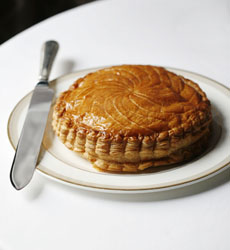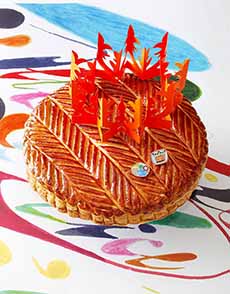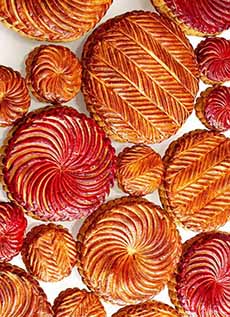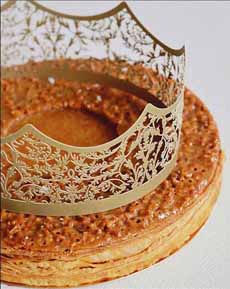Bake A Galette Des Rois, Or Epiphany Cake: The Recipe
|
|
Bûches de Noël, fruitcake and Christmas cookies are enjoyed throughout the holiday season. In France, the celebratory confections continue into January with an Epiphany Cake, or Galette des Rois, French for kings’ cake (a galette is a flat cake of pastry). You can order a Galette des Rois from a French bakery. Alternatively, a recipe to bake your own is below. But first, some background. In January, the windows of French pastry shops showcase Galettes des Rois to celebrate the Feast of the Epiphany‡, or Fête de l’Épiphanie in French (January 6th).* The cake is enjoyed beginning a few days before Epiphany, and continuing for a few days after. Some families get a new cake every day! January 6th is also known as the Twelfth Night, the last night of the 12 days of Christmas. To celebrate, Galettes des Rois are baked throughout France. Epiphany Cake/Galette des Rois is traditionally a puff pastry (pâte à choux) cake filled with frangipane (almond cream). Other fillings can be substituted, including almond paste, apple, caramel, chestnut, chocolate ganache, and pistachio. In Provence, in the south of France, the cake, with the medieval-era name of Gâteau des Rois, is an orange-blossom-flavored brioche crown. This style can also be found in Spain and other Spanish-speaking countries. Other versions of the Galette des Rois are made in Belgium, Germany, Portugal, and Switzerland. But one thing can’t be substituted: the fève. Originally a bean, hidden inside the cake, in modern times it has transformed into a more festive charm (initially a baby, representing baby Jesus) or another trinket that is hidden inside. The trinket can be anything from a miniature car to a cartoon character (Hello Kitty? Sponge Bob Square Pants?). When we made this cake for a group of adults, we used a key chain featuring a miniature bottle of Champagne. The French residents of New Orleans made Epiphany Cake part of the Mardi Gras celebration, and it became known as King Cake, but it’s a different style than the French Galette des Rois. Here’s more about it. Galette des Rois is believed to have originated sometime in the 13th or 14th century, and was initially known as Gâteau des Rois. A gâteau is a raised cake, frequently iced, while a galette is generally flat, crusty and often filled. The style, the terminology, or both may have changed over time. While the cake may have originated during the Middle Ages, the tradition of the fève actually has roots stretching back to the Roman Empire. During this time, the Romans celebrated the holiday of Saturnalia, a festival in honor of the pagan god Saturn, the Roman god of agriculture. According to the Roman writer Justinius, “it has been ordered that at the Saturnalia slaves should everywhere sit down with their masters at the entertainments, the rank of all being made equal” [https://en.wikipedia.org/wiki/Saturnalia]. A “king” for the day was decided via a cake with a hidden bean baked into it. This tradition has traveled up through the ages. For example, 14th-century Besançon monks of Eastern France would hide a gold coin in a loaf of bread and elect the chief of their chapter based on who got the gold coin. During this period, the royal court of France had a custom that whoever got the bean in the cake would have to provide drinks for the entire assembly [source]. The person who gets the slice with the charm becomes “king” or “queen” for the day and gets to wear the gold paper crown (provided by the bakery or your nearest party store, if you bake your own cake). But it’s an entailed honor: By tradition, the king has to provide next year’s galette. You can forgo that French tradition in favor of making the Epiphany Cake your annual party treat. Hiding some type of token in food is a pre-Christian tradition, with roots in the Roman feast of Saturnalia.† A dry bean would be hidden in a dish prepared for the household staff. The slave who got the slice with the bean would be awarded the “kingship” of the day, which included drinking, gambling, and “general bawdiness.” In fact, in France, the charm/trinket is known as la fève, the French word for bean. Americans have adopted the idea as the Mardi Gras king cake (Mardi Gras, or Fat Tuesday, is celebrated from right after Epiphany until Fat Tuesday, the day before Ash Wednesday). French chef Héléne Darroze, who commutes each week between the kitchens of the Connaught Hotel in London and her own two-Michelin-starred restaurant in Paris, recalls celebrating the Epiphany feast as a child. Growing up in southwestern France, “each year there would be a series of family parties, and the person who found the token in the cake would buy the charms for the following day’s galette.” |
|
|
She’s provided this recipe: |
||
|
HÉLÉNE DARROZE’S EPIPHANY CAKE RECIPE
Ingredients (custard thickened with flour) |

Héléne Darroze’s epiphany cake is filled with chocolate ganache (photo © Héléne Darroze). |
|
|
Preparation 1. ROLL out the puff pastry to a thickness of 3/4″ (2mm) with a rolling pin and leave it in the fridge for 1 hour. Cut two rounds of pastry (9-10 inches in diameter) and leave in the fridge. 2. MAKE the frangipane: Mix the butter, sugar, and almonds with a spatula. Add the egg and crème pâtissière little by little and finish with the zest. 3. PLACE one of the rounds of puff pastry on a pastry tray and brush some egg yolk around the edge. Pipe frangipane into the middle, add the “feve” and cover with the second round of puff pastry. Press the edges a bit and leave them in the fridge for an hour. 4. PREHEAT the oven to 350°F (180°C/gas 4). When at temperature, brush the top round with egg yolk. With the back of the knife, make small score lines from the center to the edges in a crescent shape. Repeat all the way around. Pierce with fork tines to vent. Bake for about 40 minutes. Serve warm. Variations *Epiphany derives from the ancient Greek theophany, “vision of God,” referring to the revelation of the divine nature of Jesus Christ as told by the Magi. The holiday traditionally falls on January 6th. The night before, the eve of the Epiphany, is called Twelfth Night, formerly the last day of the Christmas festivities and “a time of merrymaking.” †Saturnalia, a festival spanning December 17-23, honored Saturn, the Roman god of agriculture. ‡Epiphany, also known as Three Kings Day, is a Christian feast day that celebrates the revelation of God incarnate as Jesus Christ. Here’s more about it. ‡‡Important: Do not bake anything plastic or anything metal with paint in a cake. The plastic and paint will melt. Instead, turn the baked cake over and insert the trinket from underneath. It is easier to insert a coin, which will not impart anything harmful (just wash it first). CHECK OUT WHAT’S HAPPENING ON OUR HOME PAGE, THENIBBLE.COM. |
||







